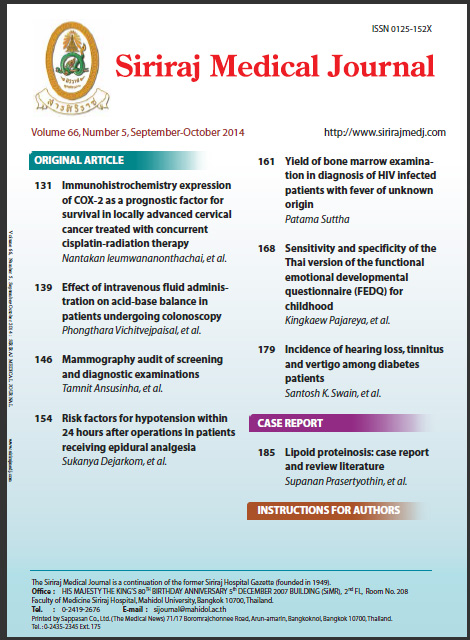Yield of Bone Marrow Examination in Diagnosis of HIV Infected Patients with Fever of Unknown Origin
Abstract
Background: HIV-infected patients are commonly found with fever of unknown origin (FUO), leading to high morbidity, prolonged hospitalization, and extensive diagnosis. Other than the noninvasive investigations, such as blood cultures or sputum examination and cultures, bone marrow aspiration or culture and biopsy can be undertaken with specific diagnostic yield for FUO.
Objective: To investigate diagnostic yield of bone marrow examination in HIV infected patients with FUO.
Methods: This study was a retrospective review of bone marrow aspiration, culture and biopsy in 84 HIV infected patients with FUO hospitalized between January 2003 and January 2013 at Bamrasnaradura Infectious Diseases Institute, Nonthaburi, Thailand.
Results: Overall, abnormal findings were found in 46 cases (diagnostic yield, 54%), with specific diagnosis by bone marrow examination in 36 cases (diagnostic yield, 42.8%). Two types of diseases were observed: 1) Infectious diseases in 34 cases [17 with non tuberculous mycobacterial (NTM) infection, 8 with histoplasmosis, 6 with cryptococcosis, and 3 with tuberculosis (TB)], 2) Hematological malignant diseases in 2 cases. The clinical predictor of positive bone marrow examination (BME) was leucopenia (p< 0.05).
Conclusion: Bone marrow examination should be recommended as a useful diagnostic tool to yield specific diagnosis for the evaluation of appropriate treatments in HIV-infected patients with FUO.
Keywords: Bone marrow examination, fever, HIV infected patients
Downloads
Published
How to Cite
Issue
Section
License
Authors who publish with this journal agree to the following conditions:
Copyright Transfer
In submitting a manuscript, the authors acknowledge that the work will become the copyrighted property of Siriraj Medical Journal upon publication.
License
Articles are licensed under a Creative Commons Attribution-NonCommercial-NoDerivatives 4.0 International License (CC BY-NC-ND 4.0). This license allows for the sharing of the work for non-commercial purposes with proper attribution to the authors and the journal. However, it does not permit modifications or the creation of derivative works.
Sharing and Access
Authors are encouraged to share their article on their personal or institutional websites and through other non-commercial platforms. Doing so can increase readership and citations.










